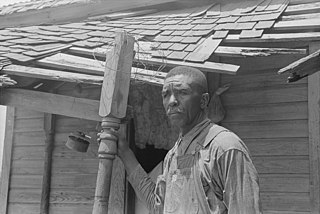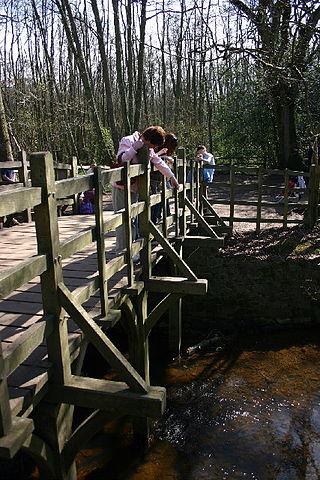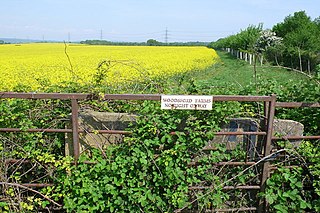Eminent domain, land acquisition, compulsory purchase, resumption, resumption/compulsory acquisition, or expropriation is the power to take private property for public use. It does not include the power to take and transfer ownership of private property from one property owner to another private property owner without a valid public purpose. This power can be legislatively delegated by the state to municipalities, government subdivisions, or even to private persons or corporations, when they are authorized to exercise the functions of public character.

A tenant farmer is a person who resides on land owned by a landlord. Tenant farming is an agricultural production system in which landowners contribute their land and often a measure of operating capital and management, while tenant farmers contribute their labor along with at times varying amounts of capital and management. Depending on the contract, tenants can make payments to the owner either of a fixed portion of the product, in cash or in a combination. The rights the tenant has over the land, the form, and measures of payment vary across systems. In some systems, the tenant could be evicted at whim ; in others, the landowner and tenant sign a contract for a fixed number of years. In most developed countries today, at least some restrictions are placed on the rights of landlords to evict tenants under normal circumstances.

The freedom to roam, or "everyman's right", is the general public's right to access certain public or privately owned land, lakes, and rivers for recreation and exercise. The right is sometimes called the right of public access to the wilderness or the "right to roam".

Common land is land owned by a person or collectively by a number of persons, over which other persons have certain common rights, such as to allow their livestock to graze upon it, to collect wood, or to cut turf for fuel.
Land law is the form of law that deals with the rights to use, alienate, or exclude others from land. In many jurisdictions, these kinds of property are referred to as real estate or real property, as distinct from personal property. Land use agreements, including renting, are an important intersection of property and contract law. Encumbrance on the land rights of one, such as an easement, may constitute the land rights of another. Mineral rights and water rights are closely linked, and often interrelated concepts.

Park, also known as South Lochs, is a huge area of land connected to the rest of Lewis only by a narrow neck between Loch Seaforth and Loch Erisort. This had a wall called Gàrradh an Tighearna built across it by the Earl of Seaforth in the early 17th century, the outline of which can still be seen.

Crofting is a form of land tenure and small-scale food production particular to the Scottish Highlands, the islands of Scotland, and formerly on the Isle of Man. Within the 19th-century townships, individual crofts were established on the better land, and a large area of poorer-quality hill ground was shared by all the crofters of the township for grazing of their livestock. In the 21st century, crofting is found predominantly in the rural Western and Northern Isles and in the coastal fringes of the western and northern Scottish mainland.
Town and country planning in the United Kingdom is the part of English land law which concerns land use planning. Its goal is to ensure sustainable economic development and a better environment. Each country of the United Kingdom has its own planning system that is responsible for town and country planning, which outside of England is devolved to the Northern Ireland Assembly, the Scottish Parliament and the Senedd.

The Crofters Holdings (Scotland) Act 1886 is an Act of the Parliament of the United Kingdom that created legal definitions of crofting parish and crofter, granted security of land tenure to crofters and produced the first Crofters Commission, a land court which ruled on disputes between landlords and crofters. The same court ruled on whether parishes were or were not crofting parishes. In many respects the Act was modelled on the Irish Land Acts of 1870 and 1881. By granting the crofters security of tenure, the Act put an end to the Highland Clearances.
The Irish Land Commission was created by the British crown in 1843 to "inquire into the occupation of the land in Ireland. The office of the commission was in Dublin Castle, and the records were, on its conclusion, deposited in the records tower there, from whence they were transferred in 1898 to the Public Record Office". It took on the role of a rent fixing commission in 1881 under the Land Law (Ireland) Act 1881. For a century it was the body responsible for re-distributing farmland in most of Ireland. It was formally abolished in 1999.

A croft is a traditional Scottish term for a fenced or enclosed area of land, usually small and arable, and usually, but not always, with a crofter's dwelling thereon. A crofter is one who has tenure and use of the land, typically as a tenant farmer, especially in rural areas.

Assynt is a sparsely populated area in the south-west of Sutherland, lying north of Ullapool on the west coast of Scotland. Assynt is known for its landscape and its remarkable mountains, which have led to the area, along with neighbouring Coigach, being designated as the Assynt-Coigach National Scenic Area, one of 40 such areas in Scotland.

Registers of Scotland (RoS) is the non-ministerial department of the Scottish Government responsible for compiling and maintaining records relating to property and other legal documents. They currently maintain 20 public registers. The official responsible with maintaining the Registers of Scotland is the Keeper of the Registers of Scotland. By ex officio, the Keeper of the Registers of Scotland is also the Deputy Keeper of the Great Seal of Scotland. The Keeper of the Registers of Scotland should not be confused with the Keeper of the Records of Scotland.

Land reform in Scotland is the ongoing process by which the ownership of land, its distribution and the law which governs it is modified, reformed and modernised by property and regulatory law.

Right of way, is the legal right, established by grant from a landowner or long usage, to pass along a specific route through property belonging to another. A similar right of access also exists on land held by a government, lands that are typically called public land, state land, or Crown land. When one person owns a piece of land that is bordered on all sides by lands owned by others, an easement may exist or might be created so as to initiate a right of way through the bordering land.
Compulsory purchase is the power to purchase rights over an estate in English land law, or to buy that estate outright, without the current owner's consent. In England and Wales, Parliament has granted several different kinds of compulsory purchase power, which are exercisable by various bodies in various situations. Such powers are meant to be used "for the public benefit". This expression is interpreted broadly.

The Land Reform (Scotland) Act 2016 is an Act of the Scottish Parliament which continues the process of land reform in Scotland following the Community Empowerment (Scotland) Act 2015. It is notable for granting Scottish ministers the power to force the sale of private land to community bodies to further sustainable development in the absence of a willing seller.

The Community Empowerment (Scotland) Act 2015 is an Act of the Scottish Parliament. The act is notable for expanding the Community Right to Buy established by the Land Reform (Scotland) Act 2003 to include urban communities and for introducing new powers for Scottish Ministers to compel owners of abandoned or neglected to land to interested community bodies.
The Scottish Outdoor Access Code provides detailed guidance on the exercise of the ancient tradition of universal access to land in Scotland, which was formally codified by the Land Reform (Scotland) Act 2003. Under Scots law everyone has the right to be on most land and inland water for recreation, education and going from place to place providing they act responsibly. The basis of access rights in Scotland is one of shared responsibilities, in that those exercising such rights have to act responsibly, whilst landowners and managers have a reciprocal responsibility to respect the interests of those who exercise their rights. The code provides detailed guidance on these responsibilities.

Compulsory purchase are powers to obtain land in Scotland that were traditionally available to certain public bodies in Scots law. Scots law classifies compulsory purchase as an involuntary transfer of land, as the owner of the corporeal heritable property (land) does not consent to the transfer of ownership.











